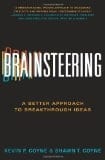By: Chuck Frey
Great questions are powerul creative tools, because they can help you to focus your thinking and lead it in fresh, new directions. But how can you develop an arsenal of creative questions that will help you to develop great ideas?
Great questions are powerul creative tools, because they can help you to focus your thinking and lead it in fresh, new directions. But how can you develop an arsenal of creative questions that will help you to develop great ideas?
Kevin and Shawn Coyne, the authors of the new book Brainsteering: A Better Approach to Breakthrough Ideas, have given this challenge a lot of thought, and they have discovered that killer creative questions tend to fall into 5 general lines of inquiry:
- Identifying unsolved customer problems
- “De-averaging” users and activities
- Exploring unexpected successes
- Imagining perfection
- Discovering unrecognized “headroom”
With this framework in place, here are some creative questions the authors suggest you use to jump-start your thinking:
Identifying unsolved customer problems
“Customers always have problems. The easiest category of high payoff questions lies in finding original ways to identify and categorize those problems.”
- What’s the biggest (avoidable) hassle customers face?
- For which users, or which occasions, are current products least well suited?
- What group of potential customers is as large as the industry’s current customer base, but doesn’t buy our product or service for one particular [addressable] reason?
“De-averaging” users and activities
“The purpose of this group of questions is… to look for outliers. To find the cases where your product or service may have been designed and delivered to meet the average needs of average customers in average situations, but where there is already evidence – hidden within existing sales or usage patterns – that uncovers useful variations in your customers and/or their behavior.”
- Who uses our product/service in surprisingly large quantities – and why?
- Which customers does our industry prefer not to serve, and why?
Exploring unexpected successes
“Here, the focus shifts even more toward fringe customers and users and their behaviors. There may not be a discernable volume of unusual customers behaving unusually just yet, but only because other potential fringe users haven’t found out yet about those customers and their behaviors. To uncover such instances, just ask your questions a little differently.”
- Who uses our products/services in ways we never expected or intended?
Imagining perfection
“Have you ever imagined what the world would be like if a product existed that would completely solve your particular problem, versus making it only marginally less painful? Well, the questions in this category are the ones that put that kind of imagination to work… Imagine perfection, and ask yourself:”
- How would we do things differently if we had perfect information about our customers and their usage habits, our distribution, and so on?
- What would we do differently if we could trust our customers not to cheat us (or didn’t care that only a few did)?
Discovering unexpected “headroom”
“All of us – individuals, teams, companies, institutions and even whole industries – conduct our work by employing a set of standard operating procedures (SOPs). SOPs might consist of ‘rules’ in the formal sense – such as laws or government regulations – or they might simply consist of conventional wisdom or habits we’ve voluntarily adopted. But the world isn’t made up of entirely identical situations, so the ideal operating procedure for a particular situation may not be the standard operating procedure at all. Of course, the world changes all the time. And that change… often creates unnoticed cases in which even the new “average” situation no longer fits with the old SOPs. Such situations create what we call ‘unrecognized headroom,’ where there’s a significant opportunity to redefine or retailor a product or process to better fit the specific circumstances of the new situation – thereby providing headroom for performance to pop up above what was previously expected.”
- Where do the “rules” already provide more flexibility than we (or others) currently take advantage of?
- Where are we operating under a set of “rules” that we’ve accepted for a long time without ever going back and re-examining what the current rules actually say?
- Which technologies underlying our production and operating processes have changed the most since we last redesigned our product or last rebuilt our manufacturing and distribution systems?
In closing, the authors urge that we not get caught up in over-focusing on today’s ideation problems:
“Many well-intentioned people get caught without a relevant arsenal of questions because the arsenal they’ve built contains questions that only pertain to challenges they’ve already planned for, not the ones they’re now called upon to undertake. Think broadly about your likely future needs. What are all the types of ideas you may be called upon to develop in the next year or two?”
I think this is great advice. There’s a world of opportunities lying within these creative questions, which I encourage you to use as a starting point to develop your own.

